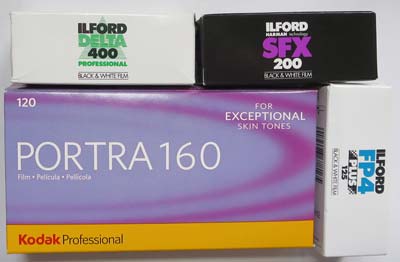Best Film Choice for your Vintage Camera
Special Needs of Vintage Cameras
Cameras manufactured before 1940 are often found to have very few controls for adjusting the aperture and the shutter speed. In fact, many old box cameras have a single aperture and a single shutter speed. For these cameras, you are heavily reliant on the characteristics of the film you use to achieve the image you are looking for. You have to let the film take the strain.

Your choice of film boils down to a combination of personal preference for grain structure, contrast etc. and the speed and exposure latitude of the film. In many cases, one feature affects another. For instance, higher speed(ISO) films tend to be grainier. Ease of processing may also play a part in your choice of film.
Ilford Black and White Films
For black and white photography, you can't go far wrong by choosing Ilford films. There are a variety of films available. The one you choose will depend on the characteristics of the film, the characteristics of your camera and, to a certain extent, your personal preference.
The majority of Ilford films break down into 2 distinct lines: The PLUS films (FP4 PLUS, HP5 PLUS and PAN F PLUS) and the DELTA PROFESSIONAL films (DELTA 100, DELTA 400 and DELTA 3200).
Traditional Emulsions
PLUS films use an established emulsion technology and have more exposure latitude than DELTA films. This makes them good for cameras where control of exposure is limited. This makes them ideal for people learning about film photography. ISO values for PLUS films are:- PAN F PLUS - 50; FP4 PLUS - 125; and HP5 PLUS - 400.
Modern Emulsions
DELTA PROFESSIONAL films use the latest film emulsion technology which give them the advantage of a lower grain to speed ratio. This means that you get less grain at the equivalent speed when compared to PLUS films presenting a marginally cleaner, sharper look. Exposure latitude is not quite so good as for PLUS films. Consequently, you would have to be more cautious when measuring and reading the light since you can lose detail in shadows and highlights. Don't worry though, the latitude is sufficient to enable restoration using digital post-processing.
Speciality Films
SFX 200 - this medium speed film has extended red sensitivity so when coupled with a [deep red filter] can produce infra-red style images. This is a popular creative style with black & white landscape photographers as the skies become a deep black and green vegetation a snow-like white.
XP2 SUPER - This fast speed film shares many characteristics with the DELTA 400 and HP5 PLUS films. The key difference is that, although this is a black and white film, this film offers the convenience of C41 colour processing which increases your processing options. You can drop it into almost any local lab, supermarket or chemist that offers film processing while your standard black & white films need to go to a specialist lab. Another feature unique to XP2 SUPER is its extremely wide latitude in exposure.
Kodak Colour Films
For colour photography, you can't go far wrong by choosing Kodak films. There are a variety of films available. The one you choose will depend on the characteristics of the film, the characteristics of your camera and, to a certain extent, your personal preference. Kodak films are developed in standard C-41 chemistry meaning they can be developed anywhere that film is processed.
Kodak Portra My personal favourite is Kodak Portra. Kodak Portra is a family of professional daylight-balanced colour negative films originally introduced in 1998 made mainly for portrait and wedding applications but is also suitable for landscape applications. It is available in speeds(ISO) of 160, 400 and 800. It is the world's finest grain high-speed color negative film. This film delivers spectacular skin tones plus exceptional colour saturation over a wide range of lighting conditions. Portra films have a wide exposure latitude which is important for vintage cameras that have little or no control over exposure.
Kodak Gold 200 is a consumer-grade film that has a wide exposure latitude which again is suited to vintage cameras. If you like the warm Kodak tones, then this film is ideal. It is easily obtained from most outlets.
Kodak Ultra Max 400 is a do-it-all consumer-grade film. It's a general-purpose, daylight-balanced, colour negative film with a sensitivity of ISO 400. It offers fine grain, deep saturation and wide exposure latitude. All of these traits make it well-suited to vintage cameras.
Film Speed (ISO)
The film speed you choose will depend on the aperture and shutter speeds available on your camera. With the slow shutter speeds of these cameras, you may be in danger of over-exposure. It will also depend on the general weather conditions you will be experiencing on your photo shoot. A sunny day in Californian or the South of France would probably call for ISO 50 or 100. A cloudy day in the North of England would be better suited by using ISO 400.
Use my Exposure Calculators and Snapshot Performance Calculator to assess the best ISO for the conditions of your photo shoot.
Remember, negative films respond better to over-exposure than to under-exposure. Most films can cope with 3 stops (8 times the light) of over-exposure and one stop (half light) of under-exposure. So, if in doubt, choose a higher ISO which will tend to overexpose the film. Most films can cope with over-exposure without problems even when using standard development procedures and times.